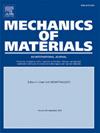A micromechanical model to predict the effective thermomechanical behavior of one-way shape memory polymers
IF 3.4
3区 材料科学
Q2 MATERIALS SCIENCE, MULTIDISCIPLINARY
引用次数: 0
Abstract
Shape memory polymers (SMPs) are a class of intelligent materials capable of recovering their original shape in response to external stimuli. This study employs a modified Mori-Tanaka (MMT) model to predict the effective thermomechanical behavior of SMPs. By utilizing a homogenization procedure, a constitutive equation describing the evolution of the effective behavior of SMPs under thermomechanical loading was proposed. The model accounted for the SMP's dual-phase structure, consisting of active and frozen phases, and determined the effective stiffness by considering each phase's shape and volume fraction. Unlike existing phase transition models, the proposed model incorporates the interaction between phases and the phase transition process throughout the thermomechanical cycle. The model was implemented in the UMAT user subroutine of the ABAQUS software to simulate the mechanical behavior of SMPs. Investigations into various inclusion phase shapes revealed that an ellipsoidal shape most accurately represents the morphology of the inclusion phase. While shape recovery is influenced by inelastic strain, the stress response of the present model showed improved agreement with experimental results due to the consideration of phase interactions during transformation. Application of the proposed model to the auxetic behavior of a re-entrant structure fabricated from PLA demonstrated that varying Poisson's ratios and cell-opening factors (CoF) can be achieved by programming different deformation magnitudes. The most negative Poisson's ratio (−0.64) was obtained at a 70° re-entrant angle induced by a 20 mm pre-displacement. Additionally, the formulation was extended to simulate particle release, highlighting its potential application in drug delivery. The findings suggested that microstructure and non-uniform deformation significantly influence the cell-opening factor.

预测单向形状记忆聚合物有效热力学行为的微观力学模型
形状记忆聚合物(SMPs)是一类能够在外界刺激下恢复其原始形状的智能材料。本研究采用改进的Mori-Tanaka (MMT)模型来预测SMPs的有效热力学行为。利用均质化方法,建立了描述热载荷作用下SMPs有效行为演化的本构方程。该模型考虑了SMP的两相结构,即活性相和冻结相,并考虑了各相的形状和体积分数,确定了有效刚度。与现有的相变模型不同,所提出的模型包含了整个热力循环中相之间的相互作用和相变过程。该模型在ABAQUS软件的UMAT用户子程序中实现,用于模拟smp的力学行为。对各种夹杂物相形状的研究表明,椭球形状最准确地代表了夹杂物相的形态。虽然形状恢复受非弹性应变的影响,但由于考虑了相变过程中相的相互作用,该模型的应力响应与实验结果更加吻合。将该模型应用于聚乳酸再入结构的形变行为,结果表明,通过规划不同的变形量,可以实现不同的泊松比和胞孔打开因子(CoF)。在20 mm预位移诱导的70°再入角处,获得了最负的泊松比(- 0.64)。此外,该配方扩展到模拟颗粒释放,突出了其在药物传递中的潜在应用。结果表明,微观结构和不均匀变形显著影响开孔系数。
本文章由计算机程序翻译,如有差异,请以英文原文为准。
求助全文
约1分钟内获得全文
求助全文
来源期刊

Mechanics of Materials
工程技术-材料科学:综合
CiteScore
7.60
自引率
5.10%
发文量
243
审稿时长
46 days
期刊介绍:
Mechanics of Materials is a forum for original scientific research on the flow, fracture, and general constitutive behavior of geophysical, geotechnical and technological materials, with balanced coverage of advanced technological and natural materials, with balanced coverage of theoretical, experimental, and field investigations. Of special concern are macroscopic predictions based on microscopic models, identification of microscopic structures from limited overall macroscopic data, experimental and field results that lead to fundamental understanding of the behavior of materials, and coordinated experimental and analytical investigations that culminate in theories with predictive quality.
 求助内容:
求助内容: 应助结果提醒方式:
应助结果提醒方式:


